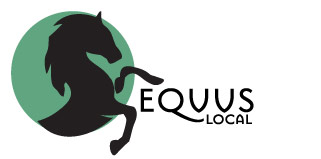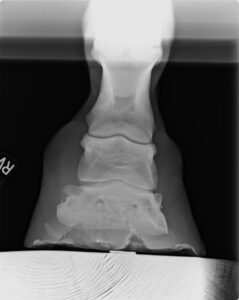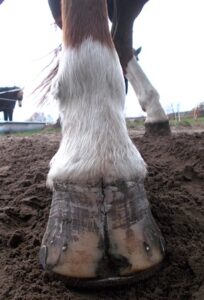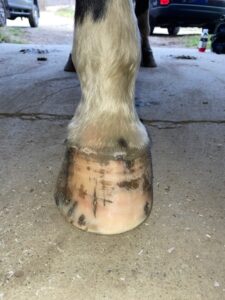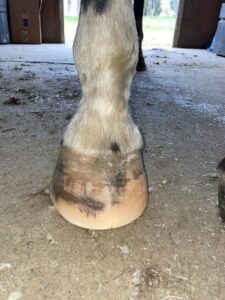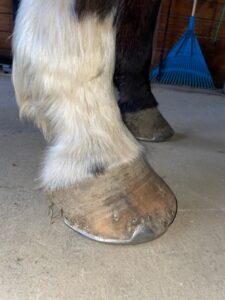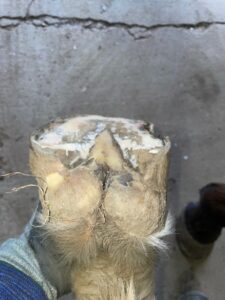The science behind the Preventative Hoof Care methodology has been developed over a period of 35 years in Germany. Its practice is well-established and widely utilized across Germany and other European countries. Since 2001, the methodology has been taught at the Institute for Hoof Orthopedics in Germany and is recognized as a separate profession from that of the farrier or barefoot trimmer.
To be licensed to practice the Preventative Hoof Care method in Europe, one must complete a 22-month training, similar to the farrier, who is trained for two years. Although both professions require thorough training, the training objectives are very different. To understand the methodological differences, we need to understand the physical processes that happen in the hoof.
A horse’s hoof is the basis of its entire musculoskeletal system, and as such is subject to certain physical forces since the horse experiences ground counterpressure from its weight. Ideally, there should be a continuous balance between horn growth and wear which would keep the limb in balance. However, uniform abrasion requires uniform loading of the limb. Unfortunately, genetically fixed predispositions and possibly acquired hoof deformations determine the use of the limb and thus the use of the hoof and consequently the wear of the hoof horn. Other factors, such as non-ideal living conditions or use of the horse or hoof protection that completely prevents abrasion represent complicating factors.
The uneven use of the hoof generates deforming forces (tensile, compression forces, leverage) within the hoof capsule that over time have a significant impact on the internal structures and deform them as well. A deforming hoof capsule can lead to further damages such as cracks, splits, discoloration, white line syndrome, etc., which are only symptoms but not the actual cause: cont…
This event was sponsored by the Orange County Horse Council and held at Juckas Stables in Pine Bush, NY.
Watch the video to hear more about this method from the author.
A shoe cannot stop the ongoing separation of the two hoof halves. On the contrary, the clip on each side increases compression forces that act their way into the coronet. The newly produced horn cannot grow down the way it wants to, alongside of the inner suspended coffin bone. The accumulated horn is splayed away from the coffin bone; tensile forces pull the epidermal laminae out of their connection with their sensitive laminae, the connection of bone and hoof wall. We can only imagine how uncomfortable it must be for the horse to walk in these “shoes”. The crack is only the side effect of a deeper-lying problem.
Wouldn’t it be helpful if we could reverse or at least decelerate the processes that cause continuous hoof deformation and lead to negative bone remodeling? In fact, it is possible with the right trimming technique.
The goal must be to influence those hoof mechanical forces that previously deformed the hoof and its coffin bone and reverse them in order to help the hoof back into its physiological shape.
This cannot be accomplished by trimming the hoof into a visually pleasing shape every time it is trimmed, with the goal of getting the horse to use or load its hoof differently. Indeed, the already acquired bone and joint shape and the inability of the hinge joints to tilt do not allow for radical changes. Instead, corrective impulses must happen early enough, temporally adapted to the horn replenishment. The idea is to maintain the hoof in its physiological shape before it comes to undesirable development and deformities.
Instead of periodically cutting the hoof into a specific shape, Preventive Hoof Care influences hoof horn abrasion without abruptly changing the position of the limb. A targeted filing and cutting technique is used to prepare only the individual parts of the hoof that need individual correction. Instead of cutting off certain parts from below (shortening the bearing edge), which can cause discomfort in the horse’s hinge joints, the abrasion is increased or the leverage and compression eliminated only in those areas that need correction. The horse then has the opportunity to use its limbs differently but is not forced to do so.
The hoof horn then has the chance to grow down accordingly to its inner bone shape.
A correction can only be gentle and successful if it is carried out at the same time as the biological bone remodeling processes happen. A gentle correction that does not force the horse to abruptly use its limb differently, but gives it the opportunity to walk itself into a healthy shape.

Distorted Hoof.
The main load is on the medial side (right in the picture). Due to the load and the fact that the hoof wall tubules could not naturally abrade on that side, they are compressed and push upwards into the coronary band. The hair stands out like a roof. We see horizontal compression lines, the tubules fold like wrinkles. That side straightens under the load while the lateral side has the opportunity to drift outward, away from the center of the load; it widens, the tubules bend. As this quarter wall is now more bent, it loses distance from coronet to ground.
Fg. 1:
Same hoof, minutes after 1. treatment. The hoof wall, the bearing edge was not cut from the bottom. The hoof is still as crooked as minutes before. Instead, leverage has been eliminated and abrasion in the right sections has been increased. The coronary band appears more even, less stressed.
The difference is that the horse can now decide for itself how to use its hoof and begin the correction.
Fig. 5:
Palmar view after 1. treatment and removing the shoe.
It shows how twisted the bulbs were due to the one-sided load and pressure (right in the picture). The bearing edge on the other side seems longer. It is not. Due to the bent, the hoof wall has lost height, the bulb has shifted downward, everything has drifted to the side. The middle sulcus is infested with thrush bacteria which have been able to thrive perfectly between the compressed bulbs. It would be a serious mistake to cut off this side now to “balance out" the hoof.
This article was written by Nadine Caban, Preventive Hoof Care Practitioner & author of the book, Hoof Physics.
If you would like to learn more about the technique Nadine discusses, you can watch a video of the Orange County Horse Council open meeting where Nadine speaks about The Preventive Hoof Care Method in the above article and visit her profile here.
